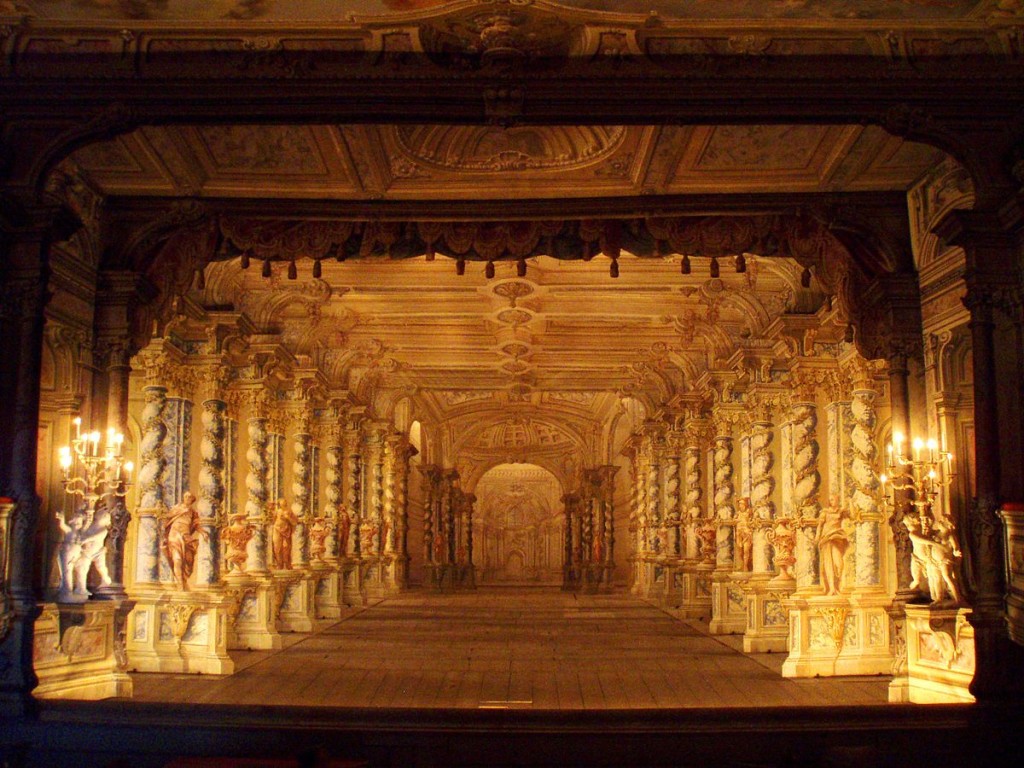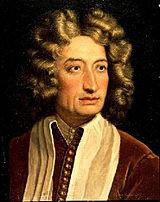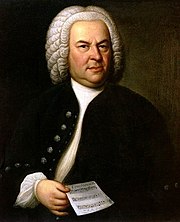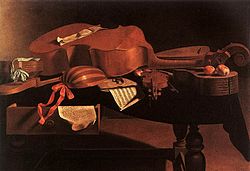12.3: Overview of Baroque Instrumental Music
- Page ID
- 72430

Introduction
Baroque music is a style of Western art music composed from approximately 1600 to 1750. This era followed the Renaissance, and was followed in turn by the Classical era. The word “baroque” comes from the Portuguese word barroco, meaning misshapen pearl, a negative description of the ornate and heavily ornamented music of this period. Later, the name came to apply also to the architecture of the same period.
During the baroque era, instrumental music became as important as vocal music.
Baroque music forms a major portion of the “classical music” canon, being widely studied, performed, and listened to. Composers of the baroque era include Johann Sebastian Bach, George Frideric Handel, Alessandro Scarlatti, Domenico Scarlatti, Antonio Vivaldi, Henry Purcell, Georg Philipp Telemann, Jean-Baptiste Lully, Arcangelo Corelli, Tomaso Albinoni, François Couperin, Denis Gaultier, Claudio Monteverdi, Heinrich Schütz, Jean-Philippe Rameau, Jan Dismas Zelenka, and Johann Pachelbel.
The baroque period saw the creation of tonality. During the period, composers and performers used more elaborate musical ornamentation, made changes in musical notation, and developed new instrumental playing techniques. Baroque music expanded the size, range, and complexity of instrumental performance, and also established opera, cantata, oratorio, concerto, and sonata as musical genres. Many musical terms and concepts from this era are still in use today.
History
The term “baroque” is generally used by music historians to describe a broad range of styles from a wide geographic region, mostly in Europe, composed over a period of approximately 150 years.
Although it was long thought that the word as a critical term was first applied to architecture, in fact it appears earlier in reference to music, in an anonymous, satirical review of the première in October 1733 of Rameau’s Hippolyte et Aricie, printed in the Mercure de France in May 1734. The critic implied that the novelty in this opera was “du barocque,” complaining that the music lacked coherent melody, was filled with unremitting dissonances, constantly changed key and meter, and speedily ran through every compositional device.
The systematic application by historians of the term “baroque” to music of this period is a relatively recent development. In 1919, Curt Sachs became the first to apply the five characteristics of Heinrich Wölfflin’s theory of the baroque systematically to music. Critics were quick to question the attempt to transpose Wölfflin’s categories to music, however, and in the second quarter of the 20th century independent attempts were made byManfred Bukofzer (in Germany and, after his immigration, in America) and by Suzanne Clercx-Lejeune (in Belgium) to use autonomous, technical analysis rather than comparative abstractions, in order to avoid the adaptation of theories based on the plastic arts and literature to music. All of these efforts resulted in appreciable disagreement about time boundaries of the period, especially concerning when it began. In English the term acquired currency only in the 1940s, in the writings of Bukofzer and Paul Henry Lang.
As late as 1960 there was still considerable dispute in academic circles, particularly in France and Britain, whether it was meaningful to lump together music as diverse as that of Jacopo Peri, Domenico Scarlatti, and J.S. Bach under a single rubric. Nevertheless, the term has become widely used and accepted for this broad range of music. It may be helpful to distinguish the baroque from both the preceding (Renaissance) and following (Classical) periods of musical history.
The baroque period is divided into three major phases: early, middle, and late. Although they overlap in time, they are conventionally dated from 1580 to 1630, from 1630 to 1680, and from 1680 to 1730.
Early Baroque Music (1580–1630)

The Florentine Camerata was a group of humanists, musicians, poets and intellectuals in late Renaissance Florence who gathered under the patronage of CountGiovanni de’ Bardi to discuss and guide trends in the arts, especially music and drama. In reference to music, they based their ideals on a perception of Classical (especially ancient Greek) musical drama that valued discourse and oration. As such, they rejected their contemporaries’ use of polyphony and instrumental music, and discussed such ancient Greek music devices as monody, which consisted of a solo singing accompanied by a kithara. The early realizations of these ideas, including Jacopo Peri’s Dafne and L’Euridice, marked the beginning of opera, which in turn was somewhat of a catalyst for baroque music.
Concerning music theory, the more widespread use of figured bass (also known as thorough bass) represents the developing importance of harmony as the linear underpinnings of polyphony. Harmony is the end result of counterpoint, and figured bass is a visual representation of those harmonies commonly employed in musical performance. Composers began concerning themselves with harmonic progressions, and also employed the tritone, perceived as an unstable interval, to create dissonance. Investment in harmony had also existed among certain composers in the Renaissance, notably Carlo Gesualdo. However, the use of harmony directed towards tonality, rather than modality, marks the shift from the Renaissance into the baroque period. This led to the idea that chords, rather than notes, could provide a sense of closure—one of the fundamental ideas that became known as tonality.
By incorporating these new aspects of composition, Claudio Monteverdi furthered the transition from the Renaissance style of music to that of the baroque period. He developed two individual styles of composition – the heritage of Renaissance polyphony (prima pratica) and the new basso continuo technique of the baroque (seconda pratica). With the writing of the operas L’Orfeo and L’incoronazione di Poppea among others, Monteverdi brought considerable attention to the new genre of opera.
Middle Baroque Music (1630–1680)
The rise of the centralized court is one of the economic and political features of what is often labelled the Age of Absolutism, personified by Louis XIV of France. The style of palace, and the court system of manners and arts he fostered became the model for the rest of Europe. The realities of rising church and state patronage created the demand for organized public music, as the increasing availability of instruments created the demand for chamber music.

The middle baroque had absolutely no bearing at all on the theoretical work of Johann Fux, who systematized the strict counterpoint characteristic of earlier ages in his Gradus ad Paranassum (1725).
One pre-eminent example of a court style composer is Jean-Baptiste Lully. He purchased patents from the monarchy to be the sole composer of operas for the king and to prevent others from having operas staged. He completed 15 lyric tragedies and left unfinished Achille et Polyxène.
Musically, he did not establish the string-dominated norm for orchestras, which was inherited from the Italian opera, and the characteristically French five-part disposition (violins, violas—in hautes-contre, tailles and quintes sizes—and bass violins) had been used in the ballet from the time of Louis XIII. He did, however, introduce this ensemble to the lyric theatre, with the upper parts often doubled by recorders, flutes, and oboes, and the bass by bassoons. Trumpets and kettledrums were frequently added for heroic scenes.

In contrast to these composers, Dieterich Buxtehude was not a creature of court but instead was church musician, holding the posts of organist and Werkmeister at the Marienkirche at Lübeck. His duties as Werkmeister involved acting as the secretary, treasurer, and business manager of the church, while his position as organist included playing for all the main services, sometimes in collaboration with other instrumentalists or vocalists, who were also paid by the church. Entirely outside of his official church duties, he organised and directed a concert series known as the Abendmusiken, which included performances of sacred dramatic works regarded by his contemporaries as the equivalent of operas.
Late Baroque Music (1680–1730)

A continuous worker, Handel borrowed from others and often recycled his own material. He was also known for reworking pieces such as the famous Messiah, which premiered in 1742, for available singers and musicians.
Baroque Instruments
String Instruments

- Violino piccolo
- Violin
- Viol
- Viola
- Viola d’amore
- Viola pomposa
- Tenor violin
- Cello
- Contrabass
- Lute
- Theorbo
- Archlute
- Angélique
- Mandolin
- Guitar
- Harp
- Hurdy-gurdy
Woodwinds
- Baroque flute
- Chalumeau
- Cortol (also known as Cortholt, Curtall, Oboe family)
- Dulcian
- Musette de cour
- Baroque oboe
- Rackett
- Recorder
- Bassoon
Brasses
- Cornett
- Natural horn
- Baroque trumpet
- Tromba da tirarsi (also called tromba spezzata)
- Flatt trumpet
- Serpent
- Sackbut (16th- and early 17th-century English name for FR: saquebute, saqueboute; ES: sacabuche; IT: trombone; MHG: busaun, busîne, busune / DE (since the early 17th century) Posaune)
- Trombone (English name for the same instrument, from the early 18th century)
Keyboards
- Clavichord
- Tangent piano
- Fortepiano – early version of piano
- Harpsichord
- Organ
Percussion
- Baroque timpani
- Wood snare drum
- Tenor drum
- Tambourine
- Castanets
Styles and forms
Dance Suite
A characteristic baroque form was the dance suite. Some Dance suites by Bach are called partitas, although this term is also used for other collections of pieces. The dance suite often consists of the following movements:
- Overture – The baroque suite often began with a French overture (“Ouverture” in French), which was followed by a succession of dances of different types, principally the following four:
- Allemande – Often the first dance of an instrumental suite, the allemande was a very popular dance that had its origins in the German Renaissance era. The allemande was played at a moderate tempo and could start on any beat of the bar.
- Courante – The second dance is the courante, a lively, French dance in triple meter. The Italian version is called the corrente.
- Sarabande – The sarabande, a Spanish dance, is the third of the four basic dances, and is one of the slowest of the baroque dances. It is also in triple meter and can start on any beat of the bar, although there is an emphasis on the second beat, creating the characteristic ‘halting’, or iambic rhythm of the sarabande.
- Gigue – The gigue is an upbeat and lively baroque dance in compound meter, typically the concluding movement of an instrumental suite, and the fourth of its basic dance types. The gigue can start on any beat of the bar and is easily recognized by its rhythmic feel. The gigue originated in the British Isles. Its counterpart in folk music is the jig.
These four dance types (allemande, courante, sarabande, and gigue) make up the majority of 17th-century suites; later suites interpolate one or more additional dances between the sarabande and gigue:
- Gavotte – The gavotte can be identified by a variety of features; it is in 4/4 time and always starts on the third beat of the bar, although this may sound like the first beat in some cases, as the first and third beats are the strong beats in quadruple time. The gavotte is played at a moderate tempo, although in some cases it may be played faster.
- Bourrée – The bourrée is similar to the gavotte as it is in 2/2 time although it starts on the second half of the last beat of the bar, creating a different feel to the dance. The bourrée is commonly played at a moderate tempo, although for some composers, such as Handel, it can be taken at a much faster tempo.
- Minuet – The minuet is perhaps the best-known of the baroque dances in triple meter. It can start on any beat of the bar. In some suites there may be a Minuet I and II, played in succession, with the Minuet I repeated.
- Passepied – The passepied is a fast dance in binary form and triple meter that originated as a court dance in Brittany. Examples can be found in later suites such as those of Bach and Handel.
- Rigaudon – The rigaudon is a lively French dance in duple meter, similar to the bourrée, but rhythmically simpler. It originated as a family of closely related southern-French folk dances, traditionally associated with the provinces of Vavarais, Languedoc, Dauphiné, and Provence.
Contributors and Attributions
- Revision and adaptation. Provided by: Lumen Learning and Natalia Kuznetsova. License: CC BY-SA: Attribution-ShareAlike
- Baroque Music. Provided by: Wikipedia. Located at: https://en.Wikipedia.org/wiki/Baroque_music#Instrumental. License: CC BY-SA: Attribution-ShareAlike
- The stage at the Castle Theatre, Cesky Krumlov.. Authored by: Alexwardle. Located at: https://en.Wikipedia.org/wiki/Baroque_music#/media/File:Ceskystage.jpg. License: Public Domain: No Known Copyright

